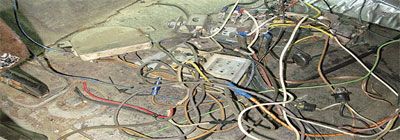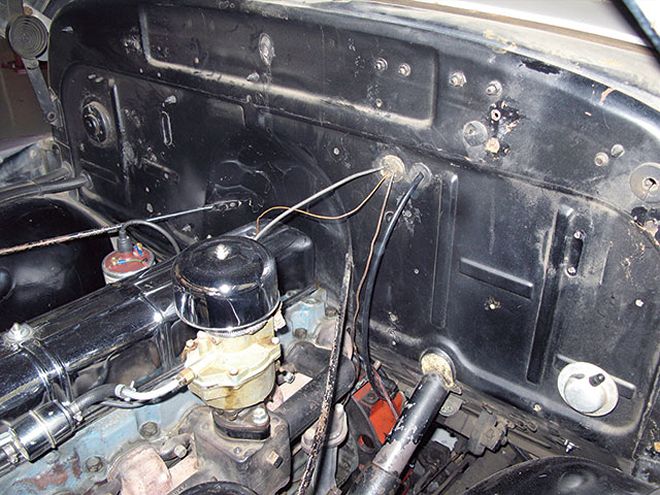
You know that old familiar saying, "You don't know what you got till it's gone"? Well, that was exactly how I'd describe the old electrical system on my '53 Chevy pickup. Since the day I purchased her a couple years back, I'd always suspected some fishy things going on with the truck's wiring, but here again another proverbial axiom came into play: "If it ain't broke, don't fix it." Well, that's exactly what I did.
Over that two-year period (during which, I drove the truck quite often), I only had one real issue with the wiring. But the failure of the stock Delco starter switch turned out to be a blessing in disguise. Had that not occurred, I may not have become fully aware of the imminent chance of a vehicle fire due to not only faulty wiring, but improperly wired components. The first clue was the fact that the entire 12-volt system had only one 20-amp fuse in use...and it was wrapped in tin foil! If that wasn't a recipe for disaster, then the main power inputs on the back of the gauge cluster with burnt-through connectors definitely were.
Looking back at it now, it's hard not to laugh a bit at the whole situation. At the same time, it's rather eerie thinking "what if," especially during those numerous trips with my toddler son riding shotgun. Thoughts like that do more than make you grateful nothing serious ever happened--they make you ensure it never will happen (at least they should). In my case, I wasted no time tearing every last bit of old wiring from the truck, and furthermore, getting myself the proper wiring kit to replace all that hazardous material.
For the '53, I initially went with American Autowire's Classic Update kit for the '47-54 Chevy 3100. However, once the kit arrived, I soon realized that my eyes may have been bigger than my stomach--in other words, too much harness for my truck's basic needs. Basically, the truck will be retaining its 235 engine; accessories will be limited to future air conditioning, and the factory amenities can be counted on one hand. That meant a pre-wired, multi-circuit panel such as the one supplied with the Classic Update kit would be overkill, so that was swapped out for a more practical Highway 15 Series. With this kit, not only is the actual fuse panel itself physically smaller, it's designed to be wired by the installer; that means instead of feeding all the bulk wire from the panel out to the designated sources, the wiring can be routed in the chassis/body from the sources first. This way, there would be no worrying about deleting a majority of the circuits pre-wired in the panel. For the individual who wants/has power windows, an overdrive transmission, a tilt steering column, and all the creature comforts my truck won't have, the Classic Update kit is definitely the way to go. But for someone like me who just wants to replace an old, decrepit electrical system in an otherwise stock truck, consider the scaled-down Highway Series (which is also available in a 20-circuit kit).
While the Highway 15 was a breeze to install, there are a couple things that should be pointed out for '47-54 truck owners. First off, if you plan to retain the stock instruments, you'll need to obtain some additional 8-gauge wire in order to facilitate the amp gauge (the kit is designed to operate a volt gauge). For this, it's necessary to run the same size wire that's feeding your generator or alternator from the battery, which is why I stated using 8-gauge. The gauge simply runs inline between the charging device (I'm using a Powermaster PowerGen alternator) and the power source. Though it's recommended to use a voltmeter for more accurate readings, especially with systems using additional components, for a basic setup this will be fine. Additionally, you will want to have the 6-volt fuel gauge converted to 12-volt (oil pressure and water temp will remain manual). Jim Carter Classic Truck Parts (800-262-3749) and Chevs of the 40s (800-999-2438) can redo factory gauges, including the mechanical ones. Lastly, the Highway 15 is designed for a traditional key-activated starter, but it's not a problem to incorporate the stock foot-activated starter switch, which is just what I did.
It's amazing what a little peace of mind can do when it comes to spending time behind the wheel of a vintage car or truck. Having the correct vital engine stats at your ready is one thing--not having to constantly worry about your truck breaking down, or worse, catching fire, is worth every penny spent updating your electrical system. If you end up deciding to rewire your own truck, but haven't done a complete wiring job before, do yourself a huge favor and get familiar with the ins and outs of a vehicle's wiring, from grounds to wire size specs and even proper crimping techniques (a lot of this info can be found on the manufacturer's Web site). CT

Even though the engine bay could stand a bit of paint and further detailing, at least there's not a string of wires running throughout any longer! Thanks to our Tech Center's Jason Scudellari for taking the time to run all the wiring beneath the surface.------>